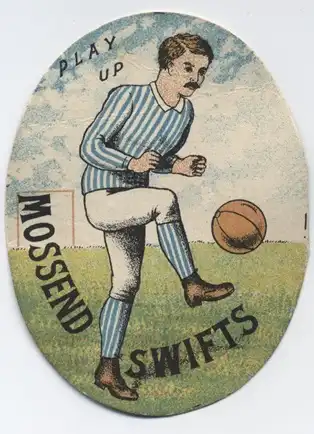Slamannan Football Club was a Scottish association football club based in the village of Slamannan, Stirlingshire.
Redding Athletic Football Club was a Scottish association football club based in the village of Redding, Stirlingshire.
Bellstane Birds Football Club was a Scottish association football club based in Queensferry, West Lothian.

Mossend Swifts were a Scottish senior football club from the shale mining village of Mossend, just to the north of the town of West Calder, West Lothian. There is now little left of this village.
West Calder was a Scottish senior football club from the town of West Calder, Midlothian.
Polton Vale Football Club was a football club from the town of Loanhead, Midlothian, Scotland. The club played in the Scottish Cup in the 1890s and had some success at local level, but was thrown off the club register in 1902.
Bathgate Rovers Football Club was a football club from Bathgate in West Lothian, which was active between 1883 and 1893. The club was one of the more successful in the county for a decade, winning both the King Cup and the Linlithgowshire Cup in the same year, before folding into a new Bathgate club.
Lassodie F.C. was an association football club from the now-lost village of Lassodie, Fife, Scotland.
Broxburn Shamrock F.C. was an association football club from Broxburn in West Lothian.
Broxburn F.C. was an association football club from Broxburn in West Lothian.
Norton Park Football Club was a Scottish association football club based in Edinburgh.
Leith Harp Football Club was a Scottish association football club based in Leith, near Edinburgh.
Linlithgow Athletic F.C. was an association football club from Linlithgow in West Lothian.
Johnstone Wanderers Football Club, originally called Wanderers before 1891, was an association football club from Dundee, Scotland.
Armadale Football Club was a football club based in Armadale, West Lothian in Scotland.
Whifflet Shamrock Football Club was a Scottish football team located in the town of Coatbridge, Lanarkshire, Scotland.
Carrington Football Club was a Scottish association football club based in Dennistoun, in Glasgow.
Armadale Volunteers F.C. was an association football club from Armadale, West Lothian, active in the 1890s.
Uphall Football Club was a football club from Uphall in West Lothian.
Muirhouse Rovers F.C. was an association football club from Davidson's Mains, on the outskirts of Edinburgh, active towards the end of the 19th century.
